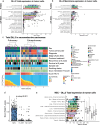Delta-like ligand 3 (DLL3) landscape in pulmonary and extra-pulmonary neuroendocrine neoplasms
- PMID: 39558076
- PMCID: PMC11574146
- DOI: 10.1038/s41698-024-00739-y
Delta-like ligand 3 (DLL3) landscape in pulmonary and extra-pulmonary neuroendocrine neoplasms
Abstract
Delta-like Ligand 3 (DLL3) targeting therapies are promising in small cell lung cancer (SCLC) treatment. However, DLL3 expression in SCLC and other neuroendocrine neoplasms (NEN) is heterogeneous and not well characterized. We describe the landscape of DLL3 at the mRNA and protein levels across SCLC, large cell neuroendocrine carcinoma (LCNEC), and non-small cell lung cancer. Additionally, we explore its expression in extra-pulmonary NEN (EP-NEN) using a standardized DLL3 IHC assay. DLL3 expression is enriched in SCLC, LCNEC along with combined histology lung cancers. Moreover, we find a wide range of DLL3 expression in high-grade EP-NEN. We describe heterogenous DLL3 expression not only in SCLC but also in different NEN types. This comprehensive characterization of DLL3 can help guide future clinical trial design targeting DLL3 in NEN including LCNEC and EP-NEN that are lacking standard of care treatment options.
© 2024. The Author(s).
Conflict of interest statement
Figures




References
Grants and funding
LinkOut - more resources
Full Text Sources

